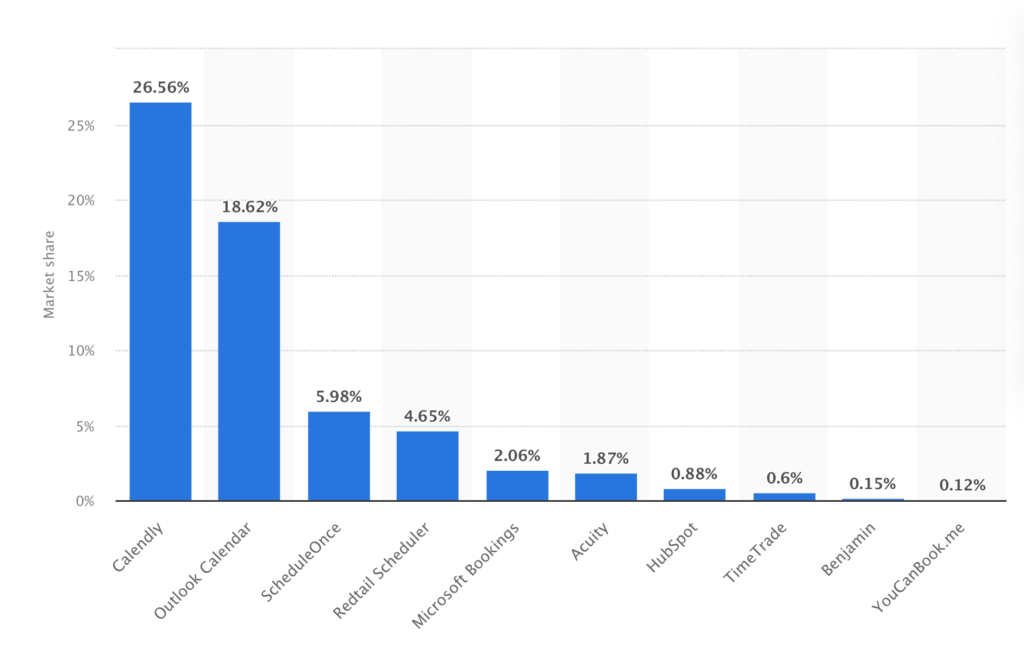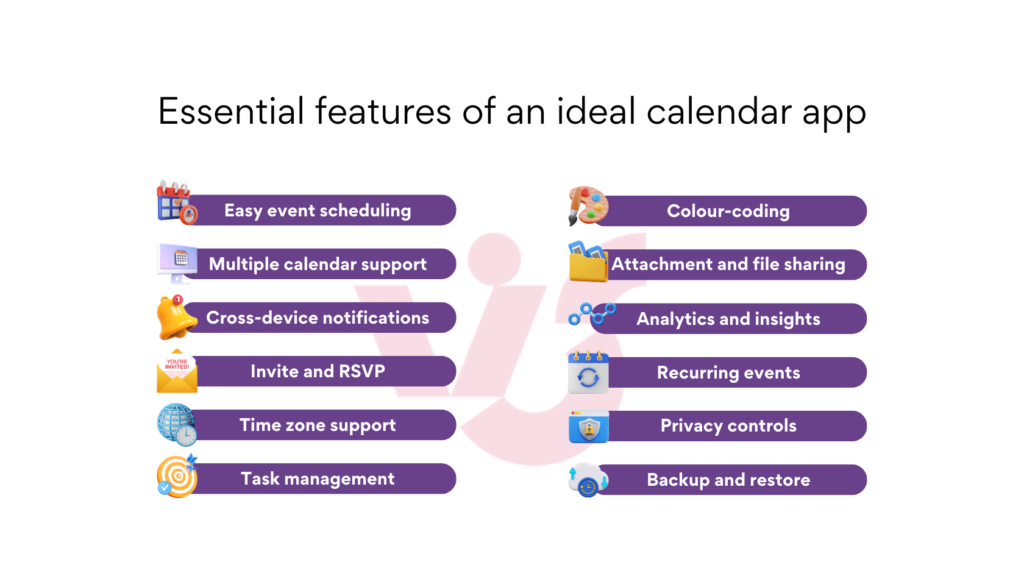Introduction
Shared calendar apps have become one of the main players in efficient team collaboration in our digital days. They offer a centralized space for scheduling and tracking events, meetings, and deadlines. Whether you’re a small startup, a medium-sized company, or a large enterprise, implementing the suitable shared calendar app can significantly improve team’s communication. Why else should you consider using a collaborative calendar?
- Improving team collaboration: Shared calendar app facilitates real-time updates, so that team members are always aligned. With the ability to share events, tasks, and schedules, these apps break down communication barriers.
- Time and task management: Keeping track of deadlines and appointments is crucial for every team. Collaborative calendar helps users organize their schedules, set reminders, and allocate time in a smart way, reducing the risk of missed deadlines or delays.
- Flexibility in distributed teams: In a globalized business landscape, many teams work remotely or across different time zones. Shared calendar app accommodates these challenges, so team members can plan their joint activities effectively regardless of their locations.
- Maintaining work-life balance: Shared calendar app is not limited to work-related activities. It can also be used for personal commitments, helping employees achieve a balance between their professional and personal lives.
In this article, we will explore the best shared calendars for business, with a focus on helping small, medium, and large enterprises make informed decisions when selecting the ideal solution. Whether you’re looking for a free shared calendar app for business, no matter if it is a startup or a feature-rich platform for a multinational corporation, this guide has you covered. We will also address common questions, such as the best calendar for small business, creating shared calendars for organizations, and managing multiple calendars effectively.
So let’s dive into the world of shared calendar apps and discover how they can change the way your business operates, improving both productivity and collaboration.
Introduction to Shared and Collaborative Calendars
Shared calendars represent a significant evolution from traditional paper calendars or personal digital calendars, offering a unified platform for multiple users to plan and manage their schedules together. Let’s discover the concept of shared and collaborative calendars in detail.
Definition and explanation
Collaborative calendar or shared calendar is a digital platform that enables multiple users or teams to access, edit, and update a common calendar. Unlike individual calendars, these tools allow users to share schedules with colleagues, making them visible to the entire team or organization.
In a shared calendar app, users can:
- Add and view events: Team members can create, edit, and delete events on the calendar, so that important dates and deadlines are always up to date.
- Assign tasks: Collaborative calendars often include task management features, letting users to assign responsibilities and track progress.
- Set reminders: Users can set reminders for upcoming events or deadlines to make sure that nothing is overlooked.
- Share and delegate: Team members can delegate tasks or share specific calendars with colleagues.
Application across companies of different sizes and industries
The use of shared calendars transcends the boundaries of company size and industry. Whether you’re running a small startup, a mid-sized agency, or a multinational corporation, these tools offer certain benefits:
- Small businesses: For small businesses, shared calendars streamline day-to-day operations. They help in scheduling client meetings, tracking project timelines, and ensuring that employees are aware of important events and tasks.
- Medium-sized enterprises: In medium-sized enterprises, shared calendars enhance cross-departmental communication. Marketing teams can coordinate product launches, while sales can efficiently schedule client visits.
- Large corporations: Large companies often have complex organizational structures and multiple teams working on different projects. Collaborative calendar helps maintain coherence across the organization, allowing various departments to sync their efforts.
Recommended article: Best Calendars for Students and Colleges
Companies that most often need shared or collaborative calendars
While shared calendars app benefits a wide range of businesses, some industries and scenarios find them especially valuable:
- Service-based businesses: Companies that rely heavily on client appointments and service delivery, such as healthcare clinics, salons, consulting firms, greatly benefit from a collaborative calendar to manage bookings and client interactions.
- Creative agencies: Marketing agencies, design studios, and advertising firms use a shared calendar app to coordinate campaign launches, content creation, and client meetings.
- Sales teams: Sales teams use a collaborative calendar to schedule client meetings, track sales appointments, and ensure that leads are followed up promptly.
- Project-based industries: Industries like construction, engineering, and software development use a shared calendar app to plan project milestones, allocate resources, and make sure project timelines are met.
In the following sections, we will learn some statistics and trends about the market of the best shared calendar apps.
Overview: Shared Calendar Apps Market Size
To understand the significance of shared calendar apps in the business world, it’s crucial to analyze the market size and explore the latest trends and statistics in this growing sector.
Analysis of market size
Online calendars for business have witnessed remarkable growth in recent years. As companies increasingly recognize the importance of efficient scheduling and time management, the demand for these solutions has surged. According to Statista, the global market size for scheduling apps, which includes shared and collaborative calendar apps, is on a steady rise.
In 2022, the market for appointment scheduling software was worth about $352.9 million. It’s expected to grow significantly and reach around $1,195.7 million by 2030. This growth is happening at a pretty fast rate, about 16.6% each year, and it’s predicted to continue from 2023 to 2030. (source)
At the forefront of the market, Calendly and Outlook Calendar are the leaders, with Calendly holding around 25% of the market share, and Outlook Calendar commanding about 18%.

Market share of scheduling apps worldwide in 2023, by program.
Source: https://www.statista.com/statistics/1331320/scheduling-apps-market-share/
Exploration of trends and statistics
a) Adoption across industries:
Shared calendar apps have found their way into numerous sectors, from healthcare and education to IT and finance. Businesses of all sizes are incorporating these tools to improve operations and team coordination, and stay organized. The adoption rates vary, but the trend is universally upward.
b) Mobile accessibility:
The rise of demand for mobile apps has made shared calendar apps more accessible and user-friendly. Apps for both Android and iOS devices have seen substantial growth, letting users manage their schedules on the go.
c) Integration with other tools:
To enhance their features, shared calendar apps increasingly integrate with other productivity tools, such as email platforms, project management software, CRM systems, and others. This integration trend simplifies workflow processes and gives enormous customization opportunities.
d) Cloud-based solutions:
Cloud-based shared calendar apps have gained prominence due to their scalability and ease of access. They eliminate the need for on-premise installations and enable real-time sync across devices, making them attractive for modern remote teams.
e) Security and data privacy:
As data security concerns rise, shared calendar app providers are placing a strong emphasis on protecting user data. End-to-end encryption and stringent security protocols are becoming standard features to ensure the confidentiality of information.
f) User-friendly interfaces:
User experience is a key focus area for shared calendar app developers. Intuitive interfaces, customizable features, and responsive design are increasingly common, making these tools accessible to a wide range of users, regardless of their technical expertise, and no matter what systems and gadgets they use.
In the following section, we will discuss what to look for in the best shared calendar app for business.
Essential Features of the Best Calendar App
Selecting the best shared calendar for business involves careful consideration of various criteria and the features it offers. To help you make the right choice, we’ll explore the key criteria for determining the best calendar app and the essential features that should be included in an ideal shared calendar app.
Criteria for determining the best calendar app
- User-friendliness: The shared calendar app should have an intuitive interface. It should be easy for team members to onboard and work with the app.
- Cross-platform compatibility: A top-tier calendar app should be accessible on multiple platforms, including web browsers, desktop (Windows and macOS), and mobile devices (iOS and Android).
- Synchronization: Calendar apps must sync across devices and platforms. This ensures that updates made on one device are reflected in real-time on all other connected devices.
- Integration with other tools: To maximize productivity, the ideal shared calendar app should integrate with other business tools such as email clients (e.g., Outlook, Gmail), project management software, and communication platforms (e.g., Slack, Microsoft Teams).
Recommended article: Best Shared Calendars for Teams
- Customization options: Users should be able to customize their calendars to suit their preferences like setting various calendar views (e.g., day, week, month) and customize event colors and labels.
- Collaboration features: Collaboration is a central function of a shared calendar app. Look for features like the ability to share calendars with team members, assign tasks, set reminders, and comment on events.
- Notification system: An effective calendar app should provide customizable notification options so that users never miss important deadlines.
- Security and privacy: Security is a must, especially when dealing with sensitive information. Make sure that the app offers robust security features, including password protection and encryption.
- Offline access: While online synchronization is crucial, the app should also offer offline access to enable users to at least view their calendars when they are not connected to the internet.
- Search functionality: A powerful search feature allows users to quickly find events and tasks, making it easier to retrieve important information.
- Compatibility with popular calendaring standards: The app should support industry-standard calendaring formats (e.g., iCal) to be compatible with other calendaring systems.
Essential features of an ideal calendar app
Now that we’ve established the criteria for choosing the best calendar app, let’s look at the specific features that should be included in an ideal collaborative calendar:
- Event scheduling: Users should be able to create, edit, and delete events with ease. This includes setting event names, descriptions, locations, durations, assigning tags and responsible employees.
- Multiple calendar support: An ideal shared calendar app should allow users to create and manage various calendars for different aspects of their projects.
- Recurrence and repeating events: The ability to set recurring events (daily, weekly, monthly) is crucial for tasks or meetings that occur on a regular basis.
- Invite and RSVP: For team events or meetings, the app should let users invite others and track RSVPs.
- Time zone support: Global businesses with distributed teams require time zone support for accurate scheduling.
- Task management: Thanks to integration with task management users can link tasks to calendar events, enhancing productivity.
- Color-coding: Customizable colors for events and calendars aid in visual organization.
- Attachment and file sharing: The option to attach files or links to events can be handy for including meeting agendas, documents and other materials.
- Analytics and insights: Some advanced shared calendar apps offer analytics to help users understand their time allocation and productivity trends.
- Cross-device notifications: Notifications should sync across devices, so that users receive timely reminders.
- Privacy controls: Users should have granular control over who can view their calendars and events.
- Backup and restore: Regular backups and a simple restore process protect against data loss.

When you assess shared calendar apps against these criteria and features, you can identify the best fit for your business, helping you improve scheduling and communication within your team. In the next section, we will explore some of the top calendar apps that excel in these aspects.
The Best Shared and Collaborative Calendars in 2024
As we enter 2024, the landscape of collaborative calendar applications continues to evolve. Now we will look at a list that makes it easier for you to choose the best shared calendar app for business.
Here’s a table summarizing the calendar software for business mentioned earlier, along with their features, suitability, and information about the availability of free versions:
| App Name | Features | Suitable For | Free Version |
|---|---|---|---|
| Google Calendar | Seamless integration, cross-platform support, collaboration, customizable, task management | Small to Large Businesses, and those who use Google Workplace | Yes |
| Outlook Calendar | Microsoft integration, cross-device compatibility, scheduling assistant | Small to Large Businesses, and those who use Microsoft ecosystem | Yes, with Microsoft 365 subscription |
| Calendly | User-friendly scheduling, integration options, customizable availability | Small to Medium Businesses | Yes |
| Teamup | Color-coded calendars, collaboration features, custom fields | Small to Medium Businesses, who prefer visual project management | Yes |
| HubSpot Calendar | Integration with HubSpot CRM, marketing automation, meeting scheduling | Small and medium companies focusing on customer interactions | Yes, with limitations |
| Asana | Task integration, collaboration, cross-platform access – ideal for task & project management | Medium to Large Businesses, for project management | Yes |
| Virto Calendar Overlay App | SharePoint & Microsoft Teams integration, multiple calendar overlays, highly customizable and scalable | All companies that use Microsoft ecosystem | Yes, free trial and up to 5 users forever |
| Apple Calendar | Seamless integration with Apple ecosystem, iCloud sync, user privacy | Individuals, Small to Medium Businesses, those who prefer Apple ecosystem | Yes |
| Cozi Family Organizer | Family-focused, cross-platform support, shared shopping lists | Families, Small Businesses, who value simplicity | Yes |
| Woven Calendar | Smart scheduling, analytics, cross-platform compatibility | Professionals and companies that value time optimization | Yes, with limitations |
| Trello Calendar Power-Up | Integration with Trello boards, visual task management, collaboration | Project-oriented companies that prefer Trello | Yes |
Please note that the availability of free versions and specific features may change over time, so it’s advisable to visit the respective websites for the most up-to-date information on these apps.
What is the best calendar app for small business?
The best calendar app for a small business can vary based on specific needs, but options like Google Calendar and Outlook Calendar are often the top choice for small teams.
What is the best shared calendar?
The title of the “best shared calendar” can depend on individual preferences and the nature of the shared calendar’s use. Popular choices include Google Calendar, Outlook Calendar, and Virto Calendar Overlay App.
How do I create a shared calendar for an organization?
Please refer to this article for instructions on how to master shared calendars in Microsoft 365 and SharePoint.
Recommended article: How to Overlay SharePoint Calendars
Tips and Tricks for Effective Usage of Shared Calendars Apps
Shared calendar apps offer a host of features to enhance team communication. To make the most of these tools and seamlessly integrate them into your daily workflows, consider the following recommendations:
1. Color-coding and labeling
Use color-coding for different types of events or projects. Assign specific colors to categories like meetings, deadlines, and personal commitments. This visual organization makes it easy to distinguish between various activities at a glance.
2. Consistent event naming
Establish a consistent event naming within your team. Clear and descriptive event titles make it easier for all to understand the purpose of an event without needing to ask anyone for some extra details.
3. Shared calendars for departments or teams
Create shared calendars dedicated to specific departments or teams. This approach keeps events and tasks organized so that relevant team members are always aware of their activities.
4. Use of tags and labels
If your shared calendar app supports tags or labels, use them to further categorize and filter events. Tags can help you quickly find all events related to a particular project, client, location, etc.
5. Synchronization with other apps
As we’ve already mentioned, explore integrations with other tools your team uses, such as email, project management software, messaging platforms. This allows information to flow seamlessly between applications, reducing manual data entry.
6. Set event reminders wisely
Customize event reminders to match the urgency and importance of each event. For critical meetings, set multiple reminders, including one well in advance. For routine tasks, a single reminder may suffice.
7. Time zone considerations
When scheduling meetings or events involving participants in different time zones, ensure that your calendar app is set to display events accurately in the respective time zones. Double-check event times to avoid scheduling conflicts.
8. Use recurring events
For regularly occurring meetings or tasks, try the recurring event feature. It simplifies scheduling so that you don’t forget to set up the same event repeatedly.
9. Collaborative event editing
Encourage team members to collaborate on event details. Shared business calendar often allows multiple users to edit event descriptions, add attachments, or make updates. This way everyone has the most current information.
10. Privacy and permissions
Be mindful of privacy settings. Ensure that sensitive events are appropriately restricted to relevant team members while keeping essential company-wide events transparent.
11. Regularly review and tidy up
Periodically review your shared calendar app to remove outdated or completed events. This will keep your calendar clutter-free and helps you to be focused on current and upcoming tasks.
12. Mobile accessibility
Download the mobile app version of your shared calendar app. This enables you to stay connected and updated on the go, ensuring that you never miss important events or updates.
13. Training and onboarding
Provide training and onboarding sessions for new team members so that they are comfortable with the new shared calendar app and its features.
14. Feedback and improvements
Encourage feedback from your team regarding the shared calendar app’s usability. Regularly assess how well it aligns with your team’s needs and look for ways to improve your workflows.
With these tips, you can harness the full potential of a shared calendar app. Remember that effective usage of these tools often requires a commitment to consistency among team members.
Conclusion
In this article we’ve explored the immense importance and advantages of incorporating shared calendars into your daily workflows, and now it’s time to take action.
Shared calendars empower your team to communicate seamlessly, collaborate effectively, and manage time efficiently. They transcend the boundaries of organizational size and industry, making them top tools for businesses of all types. Whether you’re a small startup aiming to streamline scheduling or a large corporation coordinating complex projects across time zones, online calendars for business have a solution for you.
The benefits of shared calendars Include:
- Enhanced team collaboration: Shared calendars foster transparency and real-time updates, enabling your team to work together seamlessly.
- Improved time management: Efficient scheduling, reminders, and task assignments keep you on top of your deadlines.
- Flexibility in distributed teams: Shared calendars accommodate remote work and diverse time zones, making global collaboration naturally easy.
- Work-life balance: Strike the right balance between professional and personal commitments by managing both in one place.
What is the best app to manage multiple calendars? To manage multiple calendars efficiently, consider the Virto Calendar Overlay App. This powerful tool seamlessly integrates with SharePoint Online and Microsoft Teams, making it an ideal solution for organizations already using these platforms.
Why choose Virto Calendar Overlay App:
- SharePoint integration: Virto Calendar Overlay App seamlessly integrates with SharePoint, enhancing collaboration within your organization.
- Multiple calendar overlays: Overlay multiple calendars for improved visibility, so that your team is always up to date with crucial events.
- Customization: Tailor your calendar views and settings to meet your needs and preferences.
Don’t miss out on the opportunity to boost your team’s productivity. Take the first step toward a more organized work environment by exploring the Virto Calendar Overlay App for Microsoft Teams.





